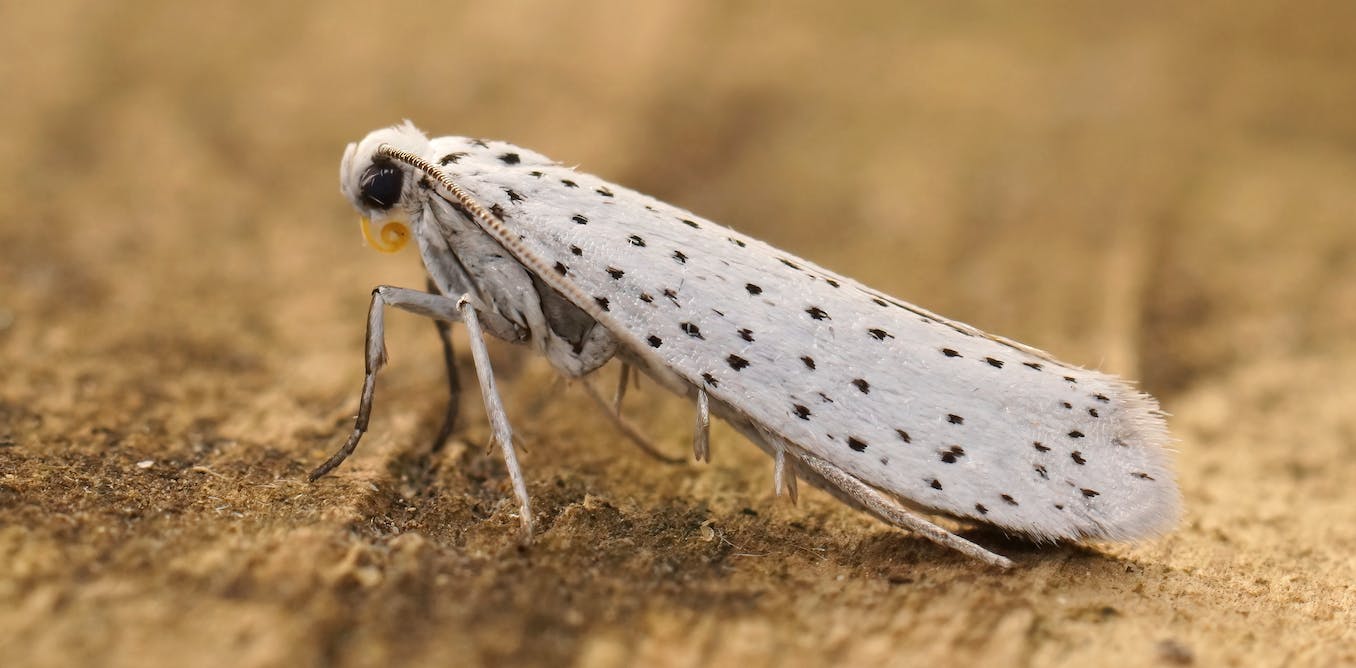[ad_1]
An acoustic battle between bats and their insect prey has been raging in the night skies for over 65 million years. Many different techniques are used, and our new study reveals the fascinating strategy of the small, deaf ermine moth, which has evolved a tiny wing structure that produces warning sounds. We hope this insight could inspire engineers to create new technology.
Bats count on their secret weapon, echolocation, to find and catch their flying prey, and in response, nocturnal insects have evolved interesting defences. Many silk moths, for instance, rely on a kind of sound-absorbing stealth cloak that makes them “disappear” from bat sonar. Some large moth species have evolved reflective decoys that draw bat attacks away from their body and towards the tips of their wings.
The next level of defence is ears that allow insects, including many moths, to pick up bat echolocation calls and fly out of harm’s way. They can also use their sensory awareness of location to blast an attacking bat with ultrasonic sounds that deter or confuse their biosonar.
However, scientists have long been puzzled about the many earless moths that cannot detect their predators and are too small for decoys. How do they protect themselves?
We recently discovered that even earless moths, such as ermine moths (Yponomeuta), use acoustic signals as a defence against bat attacks. These moths have a tiny structure in their hind wings which creates a powerful ultrasonic signal that jams the echolocating sonar of bats.
Because these moths don’t have hearing organs, they are not aware of their unique defence mechanism, and nor can they control it. Instead, the sound production mechanism is coupled to the flapping of their wings.
Protective wing beats
When we studied the ermine moth’s wing under a microscope, it became clear that one part of the wing stands out from the rest. While most of it is covered by small hairs and scales, one patch of wing is clear and located adjacent to a corrugated structure of ridges and valleys. In our new study, we found this structure produces sound perfectly tuned to confuse bats.
Rudmer Zwerver/Shutterstock
Sound is a pressure wave that travels through a fluid or solid and requires a displacement of this medium, usually a vibration, to produce noise. Large vibrating surfaces over cavities are good for amplifying sound – a good example is a tymbal drum, which has a taught skin stretched over a cavity. As the drum skin is struck by a drumstick, the skin vibrates at its natural frequencies and transmits these vibrations into the surrounding air as sound.
In ermine moths, the clear patch in the hind wing serves as the drum skin, while the corrugated structure of valleys and ridges act as drumsticks. During flight, the moth’s wing makes the ridges snap one after the other in a sequence. Each snap makes the clear patch, known as an aeroelastic tymbal, vibrate and amplifies the sound volume.
Recordings we made of ermine moths found their wings make clicking noises during flight, which we could detect using a bat detector that converts ultrasound into sound audible to humans.
Using 3D X-ray and a sophisticated microscope technique called confocal microscopy, our study’s lead author, Hernaldo Mendoza Nava, mapped out the intricate properties of the materials that make these moths’ aeroelastic tymbals. We then used computer simulations to test our hypothesis that the deformations of the corrugations stimulate the wing’s membrane in a way that produces sound. These simulations produced a sound that matched our recordings of the moths’ clicks in frequency, structure, amplitude and direction.
Some eared moths can make similar warning sounds, but none of them (so far) have been shown to do this with an aeroelastic tymbal.
To our team of biologists and engineers, these wing structures are fascinating because they rely on a mechanism that we teach our engineering students to avoid. “Snap through” is an example of a buckling instability – when a structure loses stability when loaded, and suddenly snaps into a different state.
In a buckling instability, the material doesn’t break but the structure usually loses stiffness and can even collapse. This can have catastrophic consequences for any structure that carries load, such as buildings, bridges and aeroplanes.
Inspired by nature
Historically, structures were made to be rigid enough to withstand external forces. Over the last decade, researchers and engineers have started to question this default position, and have begun to use buckling instabilities to create structures with new capabilities.
One example is engineers designing morphing structures for future aircraft wings that autonomously adapt their shape to perform better when the environment changes. The aeroelastic tymbal of ermine moths embodies this concept and demonstrates how nature can be an inspiration for new technology.
Our hope is that these deaf moths’ aeroelastic tymbals will encourage new developments in engineering domains such as acoustic structural monitoring, where structures give off sound when overloaded. This is often used to check the safety of infrastructure. It could also lead to innovations in soft robotics, where the robots are made of fluids and gels instead of metal and plastics.
[ad_2]
Source link



